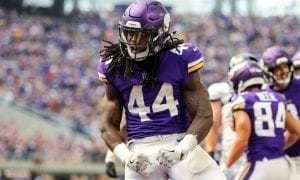A Deep Dive Into The RB3 Battle (With Some PFF)

Mike Boone and Roc Thomas have had a war of a position battle. Boone started out in the lead in camp, but Thomas took over the first preseason game in Denver. Now Boone is getting all the press from the second preseason game, and the battle rages on. With Mack Brown missing time and these two excelling, it’s becoming a two-man battle.
He's the @Vikings rookie RB with a DEVASTATING stiff arm. 💪💪💪
Every touch from Mike Boone's 91-yard, 1 TD performance! #JAXvsMIN #NFLPreseason https://t.co/JJ2qBZgasg
— NFL (@NFL) August 19, 2018
Let’s see for ourselves who’s winning – as you may understand already, box score stats can fail to tell an accurate story (especially in the preseason). I like to start with the more nuanced numbers that PFF can offer.
It shouldn’t surprise you to hear that PFF graded both players very close. Boone has a 68.8 overall grade, and Thomas has a 72.1. Thomas gets the edge based chiefly on passing game contributions, including an (obviously) high receiving grade (73.8), but also an abysmal pass blocking grade (14.5) from Mike Boone. As for just rushing, Boone (73.7) edges Thomas (69.4).
But we can go deeper than the grades. We have to think about when running backs separate themselves from other running backs. On perfectly blocked plays, most RBs can hit the hole they’ve been instructed to hit and make the play successful. Running backs make themselves matter when they convert bad run blocking into successful plays.
PFF measures this using their “elusive” rating, which combines missed tackles and yards after contact into one composite score. By that rating, Boone beats Thomas by a significant margin. Boone has forced five missed tackles, while Thomas has only forced one. That’s good for a 71.0 and a 14.5, respectively.
But taking it a step further, I decided to look at every rush from both rushers using this idea. Charting the run, I looked at two things:
First, I examined whether the back had the proper run blocking to make the play work. In situations like these, the running back doesn’t have to do anything special to make the play successful. I defined it as whether or not the back had to cut back, break a tackle, or otherwise improvise to generate a successful play.
Here’s one such play. As I detail in the tweet, Brian O’Neill fails to reach his second level block, and Boone has to stiff-arm Telvin Smith to convert an unsuccessful play into an explosive one.
So O’Neill’s worst rep of the afternoon imo actually came on his first rep. He gets slowly to the second level then looks like he struggles to read which LB he’s supposed to block. Telvin Smith gets an uncontested shot at the RB. pic.twitter.com/D3ZzVkT1NV
— Luke Braun (@LukeBraunNFL) August 19, 2018
Second, I looked at whether the play was successful. There’s some debate over how to define this, but I chose to define it as half the necessary yards on 1st and 2nd down, and of course converting any 3rd and 4th downs.
By looking at these two things, we can see which plays the running back was truly “creative” on – that is, plays that were successful because of the back using his skills, and not just sleepwalking through sealed-off run blocks.
Keep in mind that this isn’t a very strong indictment of run blocking. Even though it looks bad to have a lot of snaps where the running back has to make a move, I’m looking more at the result of the blocking and less at the process that got there. Sometimes a defender just shoots a gap and makes the RB work, and that’s nobody’s fault. A lot of these plays also had down-and-distance elements necessitating running back heroics.
So Mike Boone was able to create a successful play on 8 of his 20 “unblocked” run snaps. Roc Thomas created successful plays on 3 of his 10, and Mack Brown created 2 of just 5 unblocked run snaps before falling to an ankle injury.
Creating a successful play in spite of a missed run block is an incredible feat, and Mike Boone was able to do it eight times. That measures up to Roc Thomas’s accomplishments, which are impressive even though he often had the blocks in front of him.
Roc Thomas is FAST.https://t.co/FIDtGRKva6
— LeadingNFL (@LeadingNFL) August 12, 2018
If I were a coach and cut day were tomorrow, I’d be hard pressed to make a decision. On one hand, Boone is a far more creative runner and can salvage plays that would otherwise be ruined in a way Roc Thomas simply doesn’t. On the other, Roc Thomas has outpaced Boone as a receiver and pass blocker, which is far more relevant to a 3rd running back.
My best, nuanced take on this at the moment is that Boone makes a better insurance policy, but Thomas makes a better rotational contributor. But in both cases, the margins are razor-thin. Who would you choose?
If you were Zimmer and had to cut one right now, who’s getting axed?
— Luke Braun (@LukeBraunNFL) August 20, 2018
Thanks for reading!
You can follow me @LukeBraunNFL on Twitter, or follow @PurplePTSD or @vikingterritory for more Vikings content!
